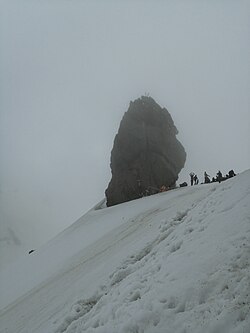Shrikhand Mahadev
Shrikhand Mahadev is a pilgrimage site for Hindus considred to be an abode of Lord Shiva and his consort Goddess Parvati. It is considered to be one of the toughest treks in India.[1] The 75 feet Shivalingam at the top of the Mountain is at the height of 5227 Meter.
Journey to the peak[edit]
Shrikhand Mahadev Kailash Yatra is a Pilgrimage trek in Kullu, Himachal Pradesh, India. There are various spots that pilgrims take before reaching Jaon, some of them include (in decreasing order of their distance from the peak), Shimla, Nirmand, Jaon. It's a 32 km (from one side) trek from base village Jaon to the Shrikhand top which is approximately 18,570 ft above the sea level. From Jaon the journey begins, and after 3 km of walking reaches Singhaad, the first Base camp where Langar (free meal for the pilgrims) is available alongside some paid food services. After that there is a 12 km straight uphill stretch to Thaachru, also known as 'Dandi-Dhaar' (roughly translating to Stick-Height), because of the stretch being a very steep slope with an elevation angle of approximately 70 degrees. One gets to see lush green Deodar trees & Streams while enrouting towards Thaachru and after the long trek of 15 km, there's a recommended halt, where one can opt to stay in tents. Thaachru is another base camp, surrounded by lush green Deodar trees and Streams, where meals and tents are available. The journey begins with a 3 km uphill trek to Kali Ghati, which is supposed to be abode of the Goddess Kali. The Shiva-Linga can be seen from this point, given the weather is clear. From Kali Ghati, there is a 1 km downhill stretch towards Bheem Talai. Departing from Bheem Talai, there is a 3 km stretch to Kunsa Valley, a green valley with Himalayan flowers surrounding it. After another 3 km stretch from here, there is the next base camp, Bheem Dawaar, having all the usual services. Just 2 km ahead is another base camp, Parvati Bagh (Parvati's garden), supposedly a garden planted by Hindu Goddess Parvati. The garden has flowers like Brahma Kamal, also known as Saussurea obvallata, which supposedly was used by the Hindu deity Shiva to plant an elephant's head on Ganesha, the god of New Beginnings. 2 km from there, is the next spot Nain Saravor (meaning, Eye's Lake), and revered to be a holy lake, and numerous people reporting physical healing of old diseases, and impairments after dipping in the lake. After this, is the final stretch of approximately 3 km to the peak, through rocky terrains, to the peak, where the lingam is situated. The peak, alongside having Shiva's lingam also has a mountain for Lord Kartikeya, behind the main Shiva mountain.[2]
References[edit]
- ↑ Chaudhry, M. (2003). Guide to Trekking in Himachal: Over 65 Treks and 100 Destinations. Indus Publishing Company. p. 204. ISBN 978-81-7387-149-8. Archived from the original on 28 June 2018. Retrieved 28 June 2018.
Another trek is to Shrikhand Mahadev (5155 m), considered the abode of Lord Shiva. It is difficult trek involving many days. Ani to Khanag is twenty kilometres on a very well-defined trek. Shoja, a beautiful resting place far away from the world ...
- ↑ Pal, Gaurav. "Shri Khand Kailash Trek in Himachal Pradesh, India". Tripoto. Retrieved 2020-06-30.

